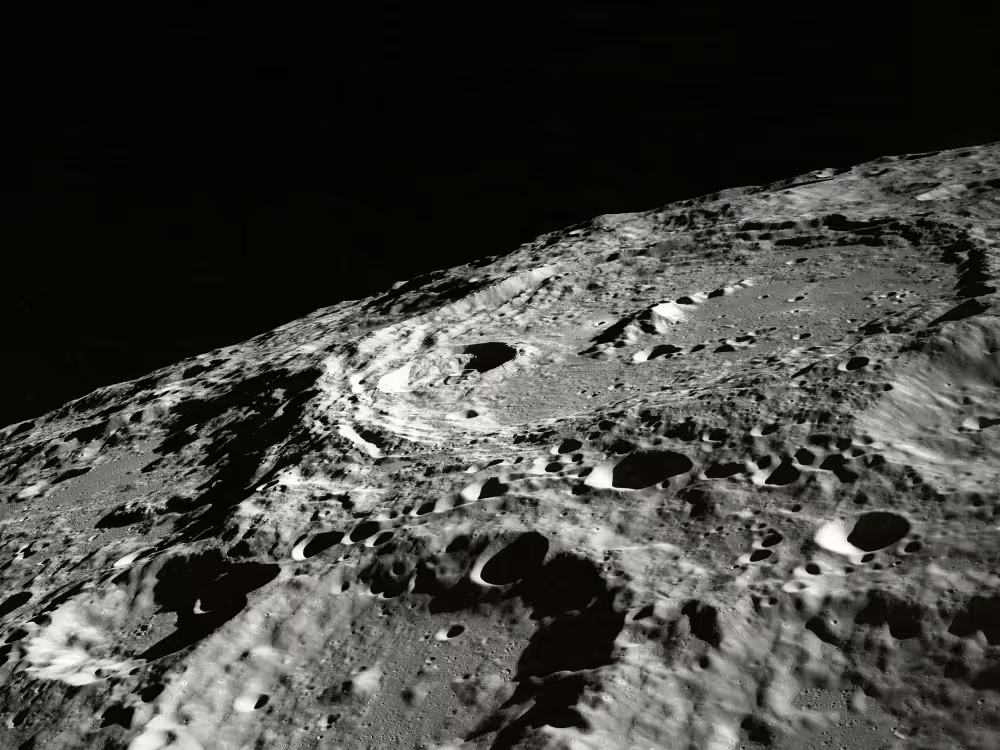Gene Cernan was the last human to step foot on our nearest celestial body, way back in 1972. And then, for a while, Man lost interest in the Moon. It’s only recently that we’ve decided to go back. And this time we’re setting up shop.
NASA’s Artemis II mission, slated for February 2026, will carry four lucky astronauts – three men and one woman – around the Moon. Artemis III aims to land humans near the lunar south pole, currently scheduled in mid-2027, where frozen water could power rockets and sustain life. The agency also plans to deploy a nuclear reactor on the surface by 2030 to provide continuous energy for future bases.
The legal vacuum of space
The 1967 Outer Space Treaty bans nations from claiming territory on celestial bodies, framing space as the “province of all mankind.” In 1979, the Moon Agreement declared the Moon’s resources the “common heritage of mankind.” But not a single major spacefaring nation signed it.
Instead, the US Commercial Space Launch Competitiveness Act (2015) granted American companies rights to whatever resources they extract off-world. The Artemis Accords of the 2020s extend this logic to partner nations, creating de-facto ‘safety zones’ around planned lunar bases. Luxembourg, the UAE, Japan, and South Korea have adopted similar frameworks.
🌔 Cislunar market bulletin I
It’s 9:30 a.m. Coordinated Lunar Time, and the market at Shackleton Crater opens. Traders on Earth watch as the first futures for lunar water-ice tick higher on screens in Dubai, Singapore, and New York. The LUNX index, tracking regolith extraction, orbital logistics, and cislunar energy, jumps 2%. The Moon’s south pole is now the commodity hub of the 2040s. Water is fuel, regolith is feedstock, helium-3 is still speculative but priced anyway. Settlements transmit over NASA’s Delay-Tolerant Network to clearing houses in Luxembourg and Tokyo, where lunar credit swaps trade overnight.
Red flag
The Americans won’t be alone up there. China’s Chang’e-7 mission, launching in 2026, will target the south pole to map deposits of water-ice. China’s crewed landing programme is set to launch before 2030.
Chang’e-8 will test local 3D manufacturing and printing with lunar regolith – a loose, lunar soil which contains some useful elements and will act as ‘cement’ for construction on the Moon. All this activity is laying the groundwork for what Beijing calls the International Lunar Research Station (ILRS), a permanent base built with Russia and other partners.
The goal is to have an operational outpost near the south pole by 2035 powered by solar arrays and, eventually, a small nuclear reactor. Under the ILRS framework, China envisions a “lunar life centre, energy centre, and data centre” – the genesis of a burgeoning Moon economy.
The financial frontier
NASA outsources its transport and lander programmes to firms such as SpaceX and Blue Origin. Luxembourg’s space-mining registry and the UAE’s National Space Fund act as quasi-development banks for lunar commerce. The European Space Resources Innovation Centre (ESRIC) supports pilot projects on regolith extraction and water-ice processing.
The European Space Agency’s (ESA) Moonlight programme aims to set up a dedicated lunar comms and navigation infrastructure. ESA has framed Moonlight as enabling services and business models for a ‘lunar economy’, not just for scientific hijinks.
Moonlight’s constellation of satellites – four for navigation, one for communications – promises high-speed, low-latency data transfer across the 400,000 km Earth-Moon distance, the area known as cislunar space.
As humankind sets its sights on solar system adventure, the Moon is shaping up to be a strategic hub for energy, data, and logistics. Launching rockets from the Moon is, once established, cheaper and easier than on Earth, for a variety of economic and scientific reasons. See: lack of gravity.
🌓 Cislunar market bulletin II
The European Space Resources Bank has approved its first lunar collateralised loan. The borrower is an infrastructure consortium building the third permanent habitat near the Moon’s south pole. It pledges throughput rights on the water pipeline connecting Shackleton Base to the orbital depot at Gateway Station. The bonds are denominated in Lunar Standard Credits, a digital currency backed by a basket of Earth sovereigns and audited via the Artemis Clearing Union, the so-called ‘Bretton Woods in space’.
Green cheese
So, what’s up there? Well, the Moon’s crust does contain rare earth elements (REEs), things like neodymium, lanthanum, yttrium, and cerium. These scarce materials are in more or less every piece of modern tech here on Earth, from batteries and electronics to speakers and hard drives, as well as renewable energy tech, alloys, lenses and just about everything with a microchip in it.
These materials – which, on Earth, are mainly found in China – were confirmed in samples brought back by the Apollo missions and China’s Chang’e probes. But as they tend to only appear in patchy formations on the Moon, extracting them would require vast energy, heavy processing, and infrastructure that doesn’t exist off-world. Instead, they’ll most likely be fought over here on Earth. Or mined out of asteroids, which we’ll explore another time.
What nations will be really after are the materials needed to sustain life while on the lunar surface – and beyond! Stuff like water, regolith, Helium-3. The latter, vanishingly rare on Earth but abundant on the Moon, is pitched as a clean nuclear fuel, though commercial fusion is still very much theoretical.
Regolith contains metals and oxygen that could sustain local production. Water-ice, trapped in polar craters, is the real prize. Split into hydrogen and oxygen, it could become the rocket fuel of the solar system.
But the first commodities may not be physical at all. High-resolution lunar maps, geological surveys, and temperature readings could be sold as proprietary datasets, a lunar analogue to oilfield data.
Bretton Woods in space
Moving money and resources between Moon and Earth will have to factor in minutes-long delays, dropouts, and asymmetric links. NASA’s Delay/Disruption-Tolerant Networking (DTN) stack already runs on the ISS and has been tested from lunar orbit. Once communication is reliable, contracts can be time-stamped, data transferred, and payments settled.
NASA and the National Institute of Standards and Technology (NIST) are developing a Coordinated Lunar Time (LTC) standard to synchronise clocks across lunar orbiters, bases, and communication networks. And researchers are sketching out payment and ledger designs that cope with light-speed limits.
One idea adapts blockchain tech to DTN so value can be transferred securely despite long, unreliable hops. Another explores a Bitcoin-based standard with cryptographic ‘proof-of-transit’ to audit movement of payment data across interplanetary links. There’s even a mooted AI-enhanced DTN network.
The Artemis Accords don’t specify monetary arrangements or dispute-resolution for payments. This gap may eventually see the rise of a multilateral ‘clearing union’. Outer space may shift to a form of broader space governance, where norms and market practice set de-facto rules until treaties catch up.
🌒 Cislunar market bulletin III
The Lunar Monetary Authority meets for the seventh time this year. Its governors, a mix of central bankers, astrophysicists, and trade lawyers, decide the benchmark rate for the Lunar Credit. Inflation on the Moon has risen again, driven by energy shortages at the south pole and delays in regolith supply. The Authority debates whether to raise rates by 25 basis points to steady the Lunar Credit’s peg to the Earth basket. Outside the meeting, traders in Frankfurt and Singapore mull over the statement like any other central bank release. Markets adjust, and the Lunar Credit strengthens fractionally against the dollar. A million miles of laser carries the result back through the Artemis Clearing Union, the interplanetary system that manages payments between Earth and the Moon.
Star wars
Without shared regulation, conflicts are almost inevitable. Assets need protecting. What happens when a Chinese rover drills near an American ‘safe zone’? Or if private claims overlap in the same crater? The Outer Space Treaty forbids sovereignty but has no real teeth. The last thing we need is nukes in space. Robust laws should hopefully prevent such a scenario.
The same supply chains that stretch across continents could soon extend across the vast emptiness of space. Lunar industries could become a way to shift extraction, and associated environmental costs, off-world. We don’t want to go full Wall-E and just outsource our mess. The Moon may become both a proving ground for sustainable technologies and a convenient dumping ground for unsustainable ones.
And as the first off-planet markets take shape, the same questions that defined Earth’s industrial age may reassert themselves in a new arena: who owns the resources, who bears the risk, and who cleans up when the dust, or regolith, settles?
Important information
When you invest, your capital is at risk. The value of your investments can go down as well as up and you may get back less than you invest. Freetrade does not give investment advice and you are responsible for making your own investment decisions. If you are unsure about what is right for you, you should seek professional advice.






.png)


.avif)



